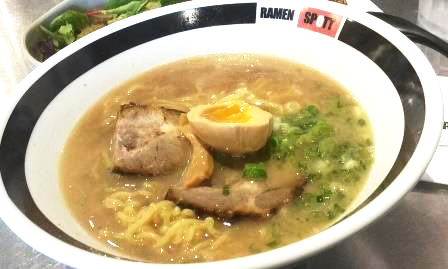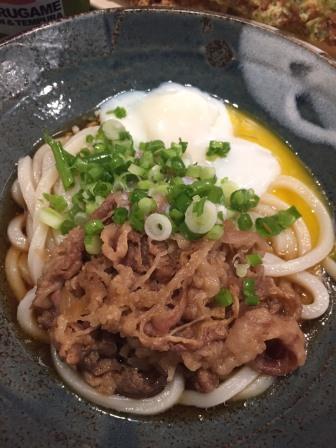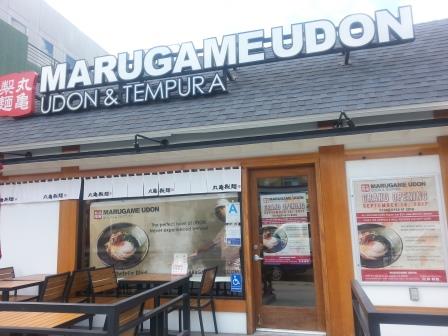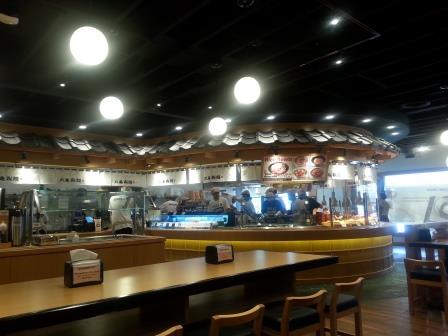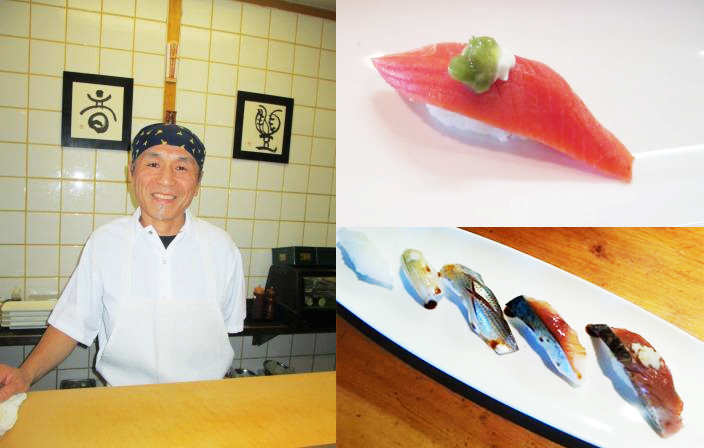Ramen and sushi by a Sri Lankan chef
By Keiko Fukuda
“I have a recent favorite ramen restaurant. You can have sushi with fresh ingredients there too,” said a friend of mine. It is Ramen Spott in Torrance. My friend continued, “I heard that their owner/chef is not Japanese, but the taste is authentic.” I got interested even more.
I checked their website. Surprisingly, there are 18 different kinds of ramen dishes. The fabulous lineup that contains tonkotsu, yuzu-shio, veggie, and nira-moyashi makes you hungry. I got an appointment to interview the owner/chef, Duke Sanji on a later day. He said, “There were only 10 (kinds of ramen dishes) when I opened the restaurant 2 years ago. The current number has been reached after receiving requests from the customers. New items were developed and added to the menu one by one.” Mr. Sanji is from Sri Lanka. After graduating from college, he got a diploma from a cooking school. He then worked at the Hilton Hotel in Colombo, Sri Lanka as a sushi chef. Then, he gained authentic Japanese cuisine experience for 3 years, and then worked at various hotels as a chef in Kuwait, Dubai, etc.
After working as a head chef at a Japanese restaurant in Los Angeles, he opened Sushi Duke in 2006 in Hermosa Beach, and then in Redondo Beach. He made his restaurants grow to be popular places filled with many regular customers with his skills in cooking that reflect his long experience. However, the Redondo Beach restaurant was forced to close due to a fire in the neighborhood. After that, he opened a ramen specialty restaurant called Ramen Spott in Torrance near the beach. He then decided to run only this one restaurant, Ramen Spott, and added a sushi menu. When you think of it, it seems like there are some, but there are actually not really any Japanese restaurants where you can enjoy both ramen and sushi at the same place.
As introduced earlier in this article, there are 18 different ramen dishes on the menu. Sanji says, “Yuzu Shio and Nira Moyashi are particularly popular among Japanese customers, and Tonkotsu Black Garlic is also popular. I also want to recommend Seafood Shio, Spicy Miso, and Coconut ramen.” So many recommendations make it difficult to choose, but their lunch time special can be a happy solution. A set that includes a ramen of your choice with salad and fried rice is $7.50. You may be able to find your favorite ramen by trying a different ramen in the set each time you visit for lunch. There is an even better deal, which is $5 ramen as a lunch time special. However, for this deal, you can choose only one kind of ramen set as the weekly special.
On a later day, I visited again during lunch time. I ordered a lunch time special that consisted of basic shoyu ramen. It was a set menu that came with very satisfying fried rice and salad with original dressing. The ramen noodles matched perfectly with the soup. The tasty cooked egg topping gave a good impression.
Ramen is not everything here. You should really try their sushi. As mentioned earlier, Sanji started as a sushi chef. He created the sushi menu with his own eyes and tastes. He serves a wide variety of sushi dishes with fresh ingredients. The signature rolls with names like Sanji Beach, Sanji Special, etc. are also receiving good reviews.
I asked Sanji what his motto is. He said, “I want to serve the kind of Japanese food that is not easy to get here in the US. I also want to cook things that I want to eat myself.” I must say that with such a case in which you can enjoy delicious Japanese cuisine by a non-Japanese chef, you can really say that Japanese cuisine has truly become global.
スリランカ人シェフが手がけるラーメンと寿司
「最近、お気に入りのラーメン屋さんがある。新鮮なネタの寿司も食べられる」と友人が教えてくれた。トーランスにあるラーメンスポットだ。友人は続けて「オーナーシェフは日本人ではないらしいが、本格的な味」と言った。ますます興味を引かれた。
ウェブサイトを見ると、ラーメンの種類、実に18。とんこつからゆず塩、ベジー、ニラもやしと見ているだけで食欲をそそるラインナップだ。後日、取材のアポを取り付けて話を聞いたオーナーシェフのデューク・サンジさんによると、「2年前に店を開けた時は(ラーメンの種類は)10種だった。その後、お客さんの要望を受けて、次々にメニューを開発、現在の数にまで増えた」ということだ。
サンジさんはスリランカ生まれ。大学卒業後に料理学校を修了し、スリランカ、コロンボにあるヒルトンホテルに寿司シェフとして就職した。さらに、本場、日本で3年間、和食の経験を積んだ後に、クウェート、ドバイをはじめとする各地のホテルを料理人として渡り歩いた。
アメリカ、ロサンゼルスでも日本食の店でヘッドシェフを務めた後に、2006年、ハモサビーチ、続いてレドンドビーチにスシ・デュークを開店した。シェフとしての長年の経験を生かした料理で、常連を中心に賑わう店に成長。しかし、近隣店舗による火事の延焼で、レドンドビーチの店の休業を余儀なくされた。その後、ビーチに近いトーランスでラーメン店としてラーメンスポットをオープン。そして、経営する店をラーメンスポット1店に絞り、寿司をメニューに加えることにしたそうだ。考えてみれば、日本食の店でラーメンと寿司の両方を味わえる所はありそうでほとんど思い浮かばない。
ラーメンは前述のように18種類揃う。「日本人のお客さんにはゆず塩やニラもやしが人気。とんこつ・ブラックガーリックもよく出ます。シーフード、スパイシー味噌、ココナッツラーメンもおすすめです」とサンジさん。そこまで言われると迷ってしまうが、そういう時に嬉しいのがランチタイム・スペシャルだ。好きなラーメンとサラダとチャーハンがセットになって、7ドル50セント。何度かランチタイムに訪れて、様々なラーメンを試すことで、自分好みの味を発見できるかもしれない。さらに破格なスペシャルとして、ランチタイムのみ、5ドルのラーメンも登場。ただし、こちらは週替わりでどれか1種類のラーメンとなる。
後日、ランチタイムに同店を訪れた。ベーシックな醤油ラーメンのランチタイム・スペシャルをオーダー。満足感が高いチャーハンにオリジナルドレッシングがかかったサラダ、そして麺とスープが絶妙に絡まったラーメンがセットになっている。味が染みた煮卵が印象的だ。
そして、ラーメンだけでは終わらない。ここで試すべきは寿司だ。寿司シェフからスタートし、自分の目とセンスで選んだ新鮮な食材で顧客に提供される寿司のメニューもまた豊富。サンジビーチ、サンジスペシャルと名前が付いたシグネチャーロールの評判も高い。
サンジさんに料理人としてのモットーを聞くと、「ここアメリカでなかなか食べられない日本食を出したいですね。それに何よりも自分で食べたいと思える料理を作りたい」と答えた。このように日本人以外のシェフによる美味しい日本食が食べられるようになってこそ、日本食が真にグローバルな存在になったと言えるのではないだろうか。
Ramen Spot
25412 Crenshaw Blvd., Torrance CA 90505
(310)530-3900
https://www.ramenspott.com
Mon.-Sun.
11:30-14:00
17:00-23:00
Closed on Wednesday
“I have a recent favorite ramen restaurant. You can have sushi with fresh ingredients there too,” said a friend of mine. It is Ramen Spott in Torrance. My friend continued, “I heard that their owner/chef is not Japanese, but the taste is authentic.” I got interested even more.
I checked their website. Surprisingly, there are 18 different kinds of ramen dishes. The fabulous lineup that contains tonkotsu, yuzu-shio, veggie, and nira-moyashi makes you hungry. I got an appointment to interview the owner/chef, Duke Sanji on a later day. He said, “There were only 10 (kinds of ramen dishes) when I opened the restaurant 2 years ago. The current number has been reached after receiving requests from the customers. New items were developed and added to the menu one by one.” Mr. Sanji is from Sri Lanka. After graduating from college, he got a diploma from a cooking school. He then worked at the Hilton Hotel in Colombo, Sri Lanka as a sushi chef. Then, he gained authentic Japanese cuisine experience for 3 years, and then worked at various hotels as a chef in Kuwait, Dubai, etc.
After working as a head chef at a Japanese restaurant in Los Angeles, he opened Sushi Duke in 2006 in Hermosa Beach, and then in Redondo Beach. He made his restaurants grow to be popular places filled with many regular customers with his skills in cooking that reflect his long experience. However, the Redondo Beach restaurant was forced to close due to a fire in the neighborhood. After that, he opened a ramen specialty restaurant called Ramen Spott in Torrance near the beach. He then decided to run only this one restaurant, Ramen Spott, and added a sushi menu. When you think of it, it seems like there are some, but there are actually not really any Japanese restaurants where you can enjoy both ramen and sushi at the same place.
As introduced earlier in this article, there are 18 different ramen dishes on the menu. Sanji says, “Yuzu Shio and Nira Moyashi are particularly popular among Japanese customers, and Tonkotsu Black Garlic is also popular. I also want to recommend Seafood Shio, Spicy Miso, and Coconut ramen.” So many recommendations make it difficult to choose, but their lunch time special can be a happy solution. A set that includes a ramen of your choice with salad and fried rice is $7.50. You may be able to find your favorite ramen by trying a different ramen in the set each time you visit for lunch. There is an even better deal, which is $5 ramen as a lunch time special. However, for this deal, you can choose only one kind of ramen set as the weekly special.
On a later day, I visited again during lunch time. I ordered a lunch time special that consisted of basic shoyu ramen. It was a set menu that came with very satisfying fried rice and salad with original dressing. The ramen noodles matched perfectly with the soup. The tasty cooked egg topping gave a good impression.
Ramen is not everything here. You should really try their sushi. As mentioned earlier, Sanji started as a sushi chef. He created the sushi menu with his own eyes and tastes. He serves a wide variety of sushi dishes with fresh ingredients. The signature rolls with names like Sanji Beach, Sanji Special, etc. are also receiving good reviews.
I asked Sanji what his motto is. He said, “I want to serve the kind of Japanese food that is not easy to get here in the US. I also want to cook things that I want to eat myself.” I must say that with such a case in which you can enjoy delicious Japanese cuisine by a non-Japanese chef, you can really say that Japanese cuisine has truly become global.
スリランカ人シェフが手がけるラーメンと寿司
「最近、お気に入りのラーメン屋さんがある。新鮮なネタの寿司も食べられる」と友人が教えてくれた。トーランスにあるラーメンスポットだ。友人は続けて「オーナーシェフは日本人ではないらしいが、本格的な味」と言った。ますます興味を引かれた。
ウェブサイトを見ると、ラーメンの種類、実に18。とんこつからゆず塩、ベジー、ニラもやしと見ているだけで食欲をそそるラインナップだ。後日、取材のアポを取り付けて話を聞いたオーナーシェフのデューク・サンジさんによると、「2年前に店を開けた時は(ラーメンの種類は)10種だった。その後、お客さんの要望を受けて、次々にメニューを開発、現在の数にまで増えた」ということだ。
サンジさんはスリランカ生まれ。大学卒業後に料理学校を修了し、スリランカ、コロンボにあるヒルトンホテルに寿司シェフとして就職した。さらに、本場、日本で3年間、和食の経験を積んだ後に、クウェート、ドバイをはじめとする各地のホテルを料理人として渡り歩いた。
アメリカ、ロサンゼルスでも日本食の店でヘッドシェフを務めた後に、2006年、ハモサビーチ、続いてレドンドビーチにスシ・デュークを開店した。シェフとしての長年の経験を生かした料理で、常連を中心に賑わう店に成長。しかし、近隣店舗による火事の延焼で、レドンドビーチの店の休業を余儀なくされた。その後、ビーチに近いトーランスでラーメン店としてラーメンスポットをオープン。そして、経営する店をラーメンスポット1店に絞り、寿司をメニューに加えることにしたそうだ。考えてみれば、日本食の店でラーメンと寿司の両方を味わえる所はありそうでほとんど思い浮かばない。
ラーメンは前述のように18種類揃う。「日本人のお客さんにはゆず塩やニラもやしが人気。とんこつ・ブラックガーリックもよく出ます。シーフード、スパイシー味噌、ココナッツラーメンもおすすめです」とサンジさん。そこまで言われると迷ってしまうが、そういう時に嬉しいのがランチタイム・スペシャルだ。好きなラーメンとサラダとチャーハンがセットになって、7ドル50セント。何度かランチタイムに訪れて、様々なラーメンを試すことで、自分好みの味を発見できるかもしれない。さらに破格なスペシャルとして、ランチタイムのみ、5ドルのラーメンも登場。ただし、こちらは週替わりでどれか1種類のラーメンとなる。
後日、ランチタイムに同店を訪れた。ベーシックな醤油ラーメンのランチタイム・スペシャルをオーダー。満足感が高いチャーハンにオリジナルドレッシングがかかったサラダ、そして麺とスープが絶妙に絡まったラーメンがセットになっている。味が染みた煮卵が印象的だ。
そして、ラーメンだけでは終わらない。ここで試すべきは寿司だ。寿司シェフからスタートし、自分の目とセンスで選んだ新鮮な食材で顧客に提供される寿司のメニューもまた豊富。サンジビーチ、サンジスペシャルと名前が付いたシグネチャーロールの評判も高い。
サンジさんに料理人としてのモットーを聞くと、「ここアメリカでなかなか食べられない日本食を出したいですね。それに何よりも自分で食べたいと思える料理を作りたい」と答えた。このように日本人以外のシェフによる美味しい日本食が食べられるようになってこそ、日本食が真にグローバルな存在になったと言えるのではないだろうか。
Ramen Spot
25412 Crenshaw Blvd., Torrance CA 90505
(310)530-3900
https://www.ramenspott.com
Mon.-Sun.
11:30-14:00
17:00-23:00
Closed on Wednesday







